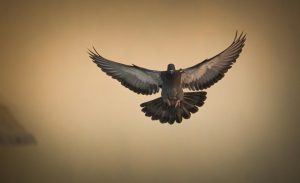
“Man’s best friend” is a phrase commonly used to describe the long standing friendship of humans and dogs. The domestic dog is certainly unique in its unwavering loyalty and centuries of devoted companionship. But there is, however, an animal that has had such close links with man that it too deserves appropriate recognition. Used as messengers, sacrifice, pets, and symbols, the service of pigeons through history may make it worthy of sharing with dogs the title of “man’s best friend.”
The pigeon, as we know it today, originated from the rock dove, Columba livia, as part of the order Columbiformes. After years of selective breeding by humans, several breeds of pigeon have emerged, including the well known Columba livia domestica, the domesticated pigeon.
Originally from Europe, Asia, and North Africa, some of the first traces of the rock dove’s ancient relationships with humans were excavated in Gorham’s Cave in Gibraltar. The sites showed signs of Neanderthals using the rock doves as food.
Hieroglyphics in Mesopotamia and Egypt also depict pigeon husbandry and the domestication of the species for food. In the early 1600s, European colonizers would introduce the species to the Americas, where a feral group was established, and domesticated pigeons would be imported to Australia in the 1870s.
Eventually, the incredible “homing instinct” possessed by pigeons became known to us, and these navigation skills were, among many other things, used to guide sailors towards land and communicate along long distances. Pigeons’ ability to reliably deliver information made them especially instrumental during World War I and World War II.
Examples of their heroism during dire times include the story of the black check cock homing pigeon, Cher Ami. According to the National Museum of American History, on the afternoon of October 4th, 1918, surrounded by German soldiers, the U.S army’s “Lost Battalion” sent Cher Ami with a note in a desperate bid for aid. Despite the “message tube hanging from the remains of the bird’s right leg and a deep wound across the chest cutting through the breastbone,” he was able to provide their exact coordinates of the battalion and administer crucial aid.
Clearly, humans have been greatly involved in the evolution of the pigeon species, but it seems that this once loved animal was quickly shunned with the rise of urbanization. The original rocky, cliffside habitat of the bird shifted to the highrise landscape of skyscrapers and city architecture.
Pigeons are often excluded from their habitat through the placing of bird spikes, not allowing them to rest on surfaces such as buildings, fences, and sometimes even trees. The Greenwich Wildlife Network even states that pest controllers often defy laws in regards to pigeons, leaving them for days trapped in netting, for example. The network has “witnessed baby pigeons dumped in bins, nests doused in bleach and adult pigeons beaten to death.”
As BBC Wildlife contributor Steve Harris puts it, the fundamental reason for this switch seems to be that “modern technology has rapidly reduced our reliance on pigeons. All that most people see today are the flocks of feral birds found in cities on every continent.”
The fact that pigeons are so much a part of our daily lives does not help their case, as many view them to be closely linked to noise, feces, and disease. On the contrary, neither the New York Department of Health nor the Centers for Disease Control and Prevention could confirm any cases of sickness spreading through human interactions with the birds.
One of the many reasons for this misguided hatred comes from our uneasiness to live so near to these animals. In his research on the sociology of cities and human-animal interactions, Journalist Jon Mooallem writes, “Rats will retreat to the sewers and bushes, and remain out of view, but pigeons invade the spaces that we’ve designated for people.” He continues, “We have waged war against pigeons, an essentially harmless enemy that has earned a level of scorn puzzlingly disproportionate to their crimes.”
The history of the relationship between pigeons and humans seems to illustrate an overarching trend in how the human race exploits nature for resources, and then abandons it without any thought or consideration for the repercussions when those resources are no longer needed.
